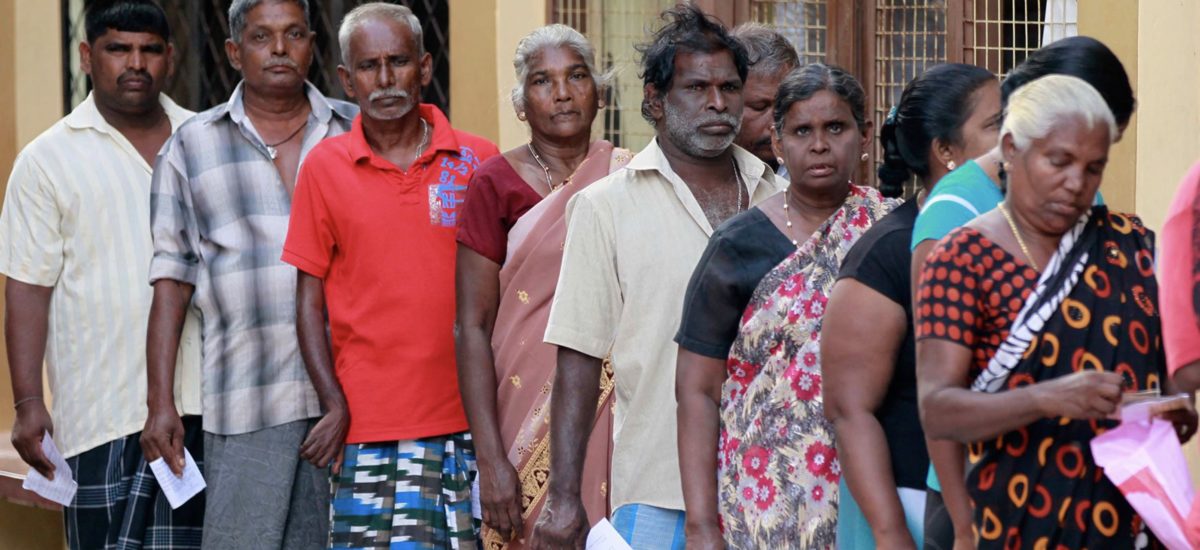Photo courtesy Dhaka Tribune
Despite the year end holiday season, the political focus is on the upcoming local government elections scheduled for February 10th next year. With nominations closing by end December, January will witness the campaigning by the candidates and the political parties for the sovereign Sri Lankan people’s vote. The election has clear ramifications beyond the local bodies, as nationally there is a redrawing of political lines as the government and opposition factions of the Sri Lanka Freedom Party (SLFP), led by President Sirisena and by former President Rajapakse contest the elections separately for the first time.
A relevant factor in the political dynamic is the politics of the North and East, which though important and impactful on Sri Lankan national life is often not taken into consideration in the political discourse. In the Tamil majority Northern Province and in the Batticalo District in the Eastern Province, the TNA dominate the political landscape. Often polling well over seventy percent in their constituencies, the truth of the matter is that the TNA, its leader and Leader of the Opposition, the veteran Rajavarothian Sambanthan has a lock on the Tamil electorate that far exceed even the mid sixty percent which Mahinda Rajapakse hit at the zenith of his post war popularity in 2010, a political high which had dissipated by end 2014.
Making the news a couple of weeks ago was the formation of a new Tamil political alliance, created supposedly to challenge the dominance of the ITAK led TNA, between the TULF of Mr. Anandasangari and the EPRLF faction of Suresh Premachandra, who finally decided to try his political luck outside the TNA. It is noteworthy that the TNA leadership have still left the door open for a post-election return to the fold by the EPRLF (Suresh faction) but not taking in the EPRLF faction led by Sugu and other more left oriented political moderates. A fairly sober assessment of the prospects of the TULF / EPRLF combine would likely indicate that the TULF which has no representation in the Sri Lankan Parliament but nonetheless, the Anandasangari family having more electoral fortune in Canada, with son Gary Anandasangari being elected to the Canadian Federal Parliament from the Scarborough area of Toronto for the governing Liberal Party. The EPRLF (Suresh faction) succeeded in electing Shivashakthi Anandan at the August 2015 election from the Vanni, though Suresh himself was unsuccessful in retaining his seat from Jaffna. Similarly, Suresh’s brother, now a Minister of the Northern Provincial Council, after the ITAK decided on principle to move away from the Provincial Administration of Chief Minister Wigneswaren, was barely elected to the Northern PC, coming in one but the last in a long list of elected TNA members, basically 29th out of 30 elected counselors. This does not augur well for the ELRLF chances in Jaffna, their pocket boroughs in the Vanni likely to provide their combine with the TULF, with some elected local representation but not much.
The other factor in the Northern and especially Eastern Province is of course the Muslim political dynamics and in this regard, the traditional Muslim leadership of the Sri Lankan Muslim Congress (SLMC) has been under some pressure in recent years from its breakaway the Sri Lankan People’s Congress of Minister Rishard Bathurdeen. The SLMC’s former General Secretary Hassen Ali, who rather acrimoniously departed from the SLMC has tied up with Rishard Bathurdeen and will likely pose a very tough challenge to the SLMC. In fact, in certain constituencies, the Bathurdeen / Hassan Ali combine will overtake the SLMC. However, in the context of national politics, this is unlikely to cause any effect as both Muslim alliances remain firmly within the national unity government. In the case of both the Muslim parties, they will run some candidates in partnership with the national parties, mostly the UNP, while in some areas, generally the Muslim majority urban councils and pradeshiya saba’s, they will run independently. An election to watch in terms of Muslim politics would be the impact that State Minister Hisbulla can make in his pocket borough of Kathankudy for the SLFP, the votes from there being insufficient for his own parliamentary election and hence the need for an SLFP national list slot for him, but nonetheless polling well.
This brings us to the electoral prospects of the national parties in the North and East. Likely to standout from among the national parties is the UNP, which has a parliamentary representation from every district including Jaffna, which is more than the SLFP led UPFA can boast of after the 2015 elections or before. Now when contesting separately as the SLFP / UPFA and the SLPP / JO, the reality is that with the minority support base of the SLFP / UPFA is solidly with President Sirisena. The SLFP effort in the North is led by its young national list MP, Angajan Ramanathan, whose either brawn or brains should deliver some SLFP votes in Jaffna, drawing deep from an old tradition of Alfred Duraiappa, the last SLFP mayor of Jaffna, whose assassination was the launch of the LTTE’s armed challenge to the Sri Lankan state.
It is however the SLPP and the JO which in the North and East will lay bare its political limitations and lack of attraction outside a section of the majority Sinhala Buddhist community. Should the good Professor Peiris and brother number two (no pun intended) Basil Rajapakse, succeed in running SLPP lists in the North, they would be fortunate to get back their candidate deposits. It was an academic and colleague from the Kumaratunga Administration days who coined the phrase the Sinhala National Alliance (SNA) as a better term for the Rajapakse comeback project, rather than the SLPP. However, it is not desirable that an aspirant for national political power has no political appeal in the North and East. The dynamics of the North and East, completes the national political landscape and any serious analysis and discourse would be incomplete without its inclusion.

